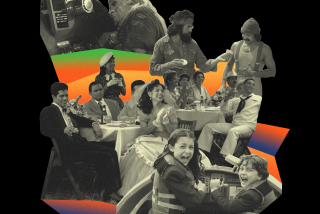Border Crossings: Mexican Nortec Mixes It Up
- Share via
Think of Ramon Amezcua as a real life comic book superhero, a masked avenger with a difficult mission: the reinvention of Mexican music.
Just as Bruce Wayne becomes Batman, the Tijuana resident has two distinct identities. During the day, he is Ramon Amezcua, a 38-year-old orthodontist and family man. At night, however, he becomes the enigmatic and increasingly popular Bostich, godfather of a revolutionary new movement known as Nortec.
It’s been years--arguably decades--since Latin music experienced the creation of a new, original genre. And although Nortec has so far stayed close to its Baja California home, where the artists record and organize local raves, the U.S. is about to join the party. On Feb. 20, Palm Records will release “Nortec Collective: The Tijuana Sessions Vol. 1,” a superb introduction to this hybrid of electronica and Mexican banda music. And critics are already raving about the sound of the future.
“Nortec music makes you realize that banda--those tubas, those snare rolls--was doing stuff rhythmically long before jungle DJs starting programming beat blitzes on sequencers,” offers Josh Kun, a professor of English at UC Riverside and a Latin music expert who has written extensively about Nortec. “I love the idea of Banda Machos or Banda del Recodo as the original junglists.”
According to Amezcua, Nortec happened almost by accident. A music fan obsessed with early electronica artists such as Kraftwerk and Klaus Schulze, whose works he heard on American radio stations during his teenage years, Amezcua began dabbling with sequencers, turntables and rhythm machines in the early ‘90s.
But Amezcua was also exposed to the bouncy sound of the banda groups of Tijuana, with their larger-than-life tuba riffs and syncopated drum beats.
One day, his friend Pepe Mogt of the band Fussible gave him a tape of banda and norteno loops and asked him to let his imagination fly.
“There were samples taken from the demos some of these groups record in order to get gigs at nightclubs and seafood restaurants,” explains Amezcua. “I took the rhythms of the snares and the sound of the tubas and processed them through various synthesizers, both analog and digital. Suddenly, I noticed a transformation taking place. The groove was the same, but the overall effect became more rhythmic and eventually turned into something new.”
A Chain Reaction of Groove Transformation
Although he was the first to perfect it, Amezcua was not alone in his discovery. Mogt had given similar samples to other musician friends, setting off a chain reaction of closely related groups: Terrestre, Clorofila, Hiperboreal, Panoptica and Plankton Man. (All are represented on the “Nortec Collective” album.)
“It’s very similar to what Talvin Singh did in England--bringing the influence of his Indian origins into electronica,” offers Ignacio Chavez Uranga, a.k.a. Plankton Man. “We do the same, only that we mix the beats with tasty Mexican sounds. When you listen to our stuff, you can feel the Latin spice in it.”
Perhaps because Nortec is such a clear encapsulation of border culture and its contrasting elements, artists from other disciplines were eager to join the movement. Thus, the Nortec aesthetic was enhanced by the input of graphic designers, architects, painters and theorists.
It’s hard not be swept up by the remarkable sonic imagination of Bostich’s “Polaris,” the opening track of the Palm compilation. In his hands, the original tuba samples become psychedelic roars that suggest mystery and decadence. Add the nervy syncopation of a neurotic snare drum and the ritualistic pulse of a fat rhythm machine and “Polaris” could be the soundtrack to an imaginary movie depicting the decadence of the Roman empire.
Interestingly, hard-core fans of traditional norteno and banda music have embraced this post-modern take on their favorite styles.
“We were afraid that people would laugh at us,” says Amezcua, recalling his first live Nortec set for an audience of 50 people in June 1999. “But the crowd was visibly moved. They started dancing to the music, some couples even doing the quebradita step to it. Now we get about 4,000 people every time we do a rave.”
The collective hopes that U.S. listeners will respond too. There are already plans in the works to institute a weekly Nortec rave at a Los Angeles club, and Palm Records is celebrating the record’s release with a massive Nortec party to be held March 3 in Tijuana.
Hoping Nortec Speaks a Universal Language
“My expectations on this record are more philosophical than practical,” says Kim Buie, head of the New York-based label’s A&R; (artists and repertoire) department. “The idea here is to turn people on to an interesting musical concept that goes beyond its regional roots. I genuinely believe college radio stations and independent retailers will embrace this project.”
“I think Nortec has the potential to reach non-Latino audiences in ways that many Latin alternative acts cannot,” says Kun, who hosts a weekly, Thursday night rock en espanol show on KJLA-TV. “While it is clearly a local movement, it is also in dialogue with the same global pop culture that young people all around the world are being exposed to.”
* Nortec City, with members of the Nortec collective at Jai Alai, March 3 at Calle Revolucion between 9th and 10th streets, Tijuana, 9 p.m. to 6 a.m. $7.
More to Read
The biggest entertainment stories
Get our big stories about Hollywood, film, television, music, arts, culture and more right in your inbox as soon as they publish.
You may occasionally receive promotional content from the Los Angeles Times.










